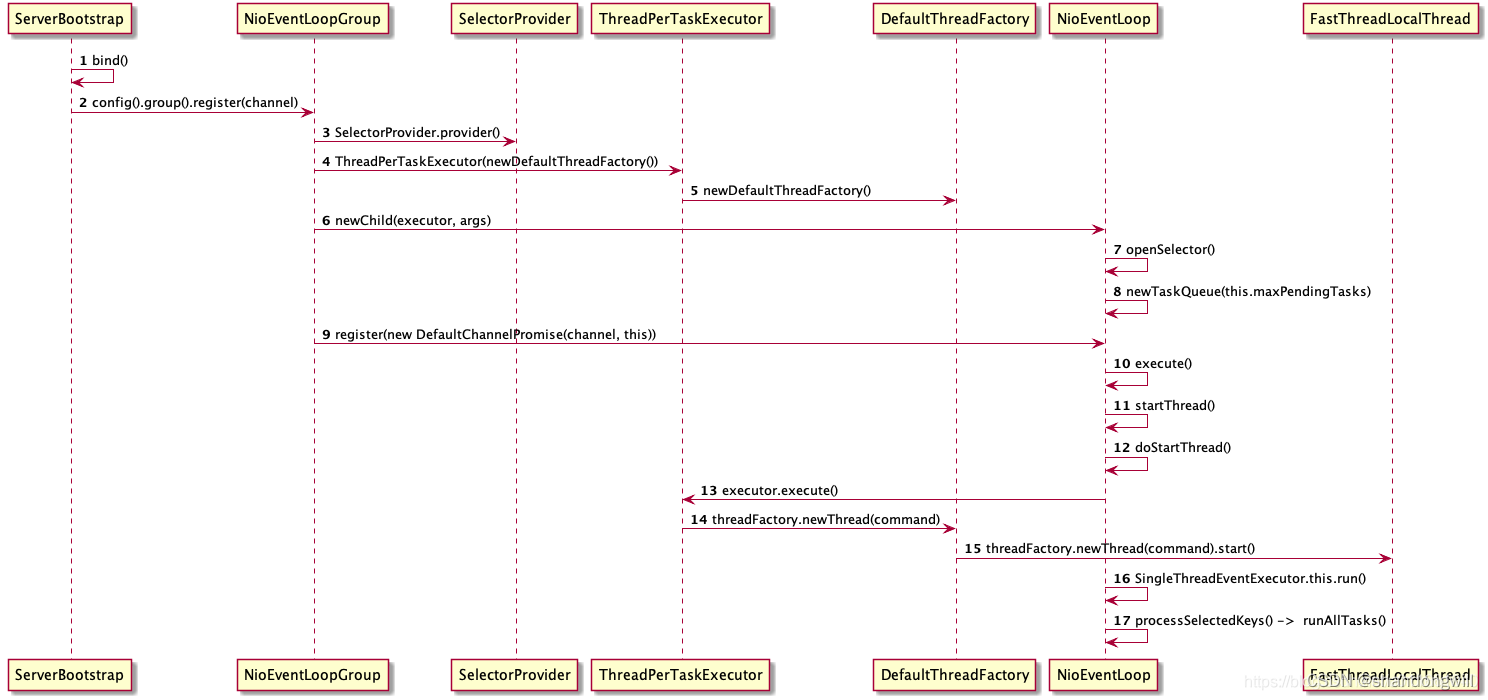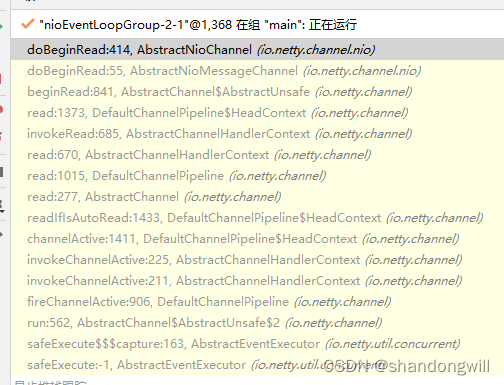前言
Netty是一个高性能、异步事件驱动的网络应用框架,用于快速开发可维护的高性能协议服务器和客户端。它的服务启动过程涉及多个组件和步骤,下面我将对Netty的服务启动过程进行详细的源码解析。
简单Netty服务器启动代码示例
public class NettyServer {
public void start() throws Exception {
// 初始化BossGroup和WorkerGroup线程池
EventLoopGroup bossGroup = new NioEventLoopGroup();
EventLoopGroup workerGroup = new NioEventLoopGroup();
try {
// 初始化ServerBootstrap
ServerBootstrap b = new ServerBootstrap();
b.group(bossGroup, workerGroup)
.channel(NioServerSocketChannel.class)
.childHandler(new ChannelInitializer<SocketChannel>() {
@Override
public void initChannel(SocketChannel ch) throws Exception {
// 添加自定义的ChannelHandler处理业务逻辑
ch.pipeline().addLast(new MyChannelHandler());
}
})
.option(ChannelOption.SO_BACKLOG, 128)
.childOption(ChannelOption.SO_KEEPALIVE, true);
// 绑定端口并启动服务
ChannelFuture f = b.bind(8080).sync();
// 等待服务关闭
f.channel().closeFuture().sync();
} finally {
// 释放资源
bossGroup.shutdownGracefully();
workerGroup.shutdownGracefully();
}
}
public static void main(String[] args) throws Exception {
NettyServer server = new NettyServer();
server.start();
}
}
class MyChannelHandler extends SimpleChannelInboundHandler<ByteBuf> {
// 实现相关的事件处理逻辑
@Override
protected void channelRead0(ChannelHandlerContext ctx, ByteBuf msg) throws Exception {
// 处理接收到的数据
}
}
主线

main线程:
- 创建NioEventLoopGroup、创建NioEventLoop
- 创建 selector
- 创建 server socket channel
- 初始化 server socket channel
- 给 server socket channel 从 boss group 中选择一个 NioEventLoop
boss 线程
- 将 server socket channel 注册到选择的 NioEventLoop 的 selector
- 绑定地址启动
- 注册接受连接事件(OP_ACCEPT)到 selector 上
NioEventLoopGroup初始化
NioEventLoopGroup 初始化的基本过程:
- EventLoopGroup(其实是MultithreadEventExecutorGroup)内部维护一个类为EventExecutor[] children 数组,其大小是nThreads;
- 在MultithreadEventExecutorGroup 中会调用newChild()抽象方法来初始化children 数组;
- 在NioEventLoopGroup 中具体实现newChild()方法,该方法返回一个NioEventLoop 实例。
初始化NioEventLoop 主要属性:
provider:在NioEventLoopGroup 构造器中通过SelectorProvider 的provider()方法获取SelectorProvider。
selector:在NioEventLoop 构造器中调用selector = provider.openSelector()方法获取Selector 对象。
关键代码
EventLoop eventLoop = EventLoopGroup.newChild(Executor executor, Object... args)
Selector selector = sun.nio.ch.SelectorProviderImpl.openSelector()
ServerSocketChannel serverSocketChannel = provider.openServerSocketChannel()
selectionKey = javaChannel().register(eventLoop().unwrappedSelector(), 0, this);
javaChannel().bind(localAddress, config.getBacklog());
selectionKey.interestOps(OP_ACCEPT);
private ChannelFuture doBind(final SocketAddress localAddress) {
final ChannelFuture regFuture = initAndRegister();
final Channel channel = regFuture.channel();
if (regFuture.isDone()) {
// At this point we know that the registration was complete and successful.
ChannelPromise promise = channel.newPromise();
doBind0(regFuture, channel, localAddress, promise);
return promise;
} else {
// Registration future is almost always fulfilled already, but just in case it's not.
final PendingRegistrationPromise promise = new PendingRegistrationPromise(channel);
regFuture.addListener(new ChannelFutureListener() {
@Override
public void operationComplete(ChannelFuture future) throws Exception {
Throwable cause = future.cause();
if (cause != null) {
// Registration on the EventLoop failed so fail the ChannelPromise directly to not cause an
// IllegalStateException once we try to access the EventLoop of the Channel.
promise.setFailure(cause);
} else {
// Registration was successful, so set the correct executor to use.
// See https://github.com/netty/netty/issues/2586
promise.registered();
doBind0(regFuture, channel, localAddress, promise);
}
}
});
return promise;
}
}
private static void doBind0(
final ChannelFuture regFuture, final Channel channel,
final SocketAddress localAddress, final ChannelPromise promise) {
// 在触发channelRegistered()之前调用此方法。给用户处理程序一个设置的机会
// the pipeline in its channelRegistered() implementation.
channel.eventLoop().execute(new Runnable() {
@Override
public void run() {
if (regFuture.isSuccess()) {
channel.bind(localAddress, promise).addListener(ChannelFutureListener.CLOSE_ON_FAILURE);
} else {
promise.setFailure(regFuture.cause());
}
}
});
}
- Selector 是在 new NioEventLoopGroup()(创建一批 NioEventLoop)时创建。
- 第一次 Register 并不是监听 OP_ACCEPT,而是 0:
selectionKey = javaChannel().register(eventLoop().unwrappedSelector(), 0, this) 。 - 最终监听 OP_ACCEPT 是通过 bind 完成后的 fireChannelActive() 来触发的。
DefaultChannelPipeline.channelActive->readIfIsAutoRead()->AbstractChannel.read()->DefaultChannelPipeline.read()->AbstractChannelHandlerContext.read() ->AbstractNioChannel.doBeginRead
AbstractNioChannel类片段
protected void doBeginRead() throws Exception {
// Channel.read() or ChannelHandlerContext.read() was called
final SelectionKey selectionKey = this.selectionKey;
if (!selectionKey.isValid()) {
return;
}
readPending = true;
final int interestOps = selectionKey.interestOps();
if ((interestOps & readInterestOp) == 0) {
selectionKey.interestOps(interestOps | readInterestOp);
}
}

- NioEventLoop 是通过 Register 操作的执行来完成启动的。
- 类似 ChannelInitializer,一些 Hander 可以设计成一次性的,用完就移除,例如授权。























 280
280











 被折叠的 条评论
为什么被折叠?
被折叠的 条评论
为什么被折叠?










